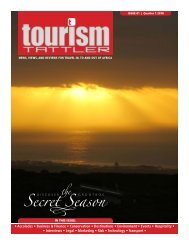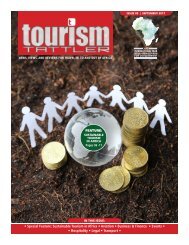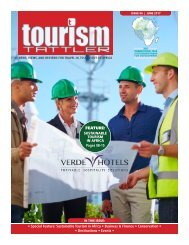Tourism Tattler May 2017 Edition
Our May edition features Karongwe Portfolio, Hotel Verde and Jaci’s Lodges - three prime examples of eco-friendly properties in South Africa who meet, and even exceed expectations as outlined in the UNWTO 2017 International Year of Sustainable Tourism for Development initiative.
Our May edition features Karongwe Portfolio, Hotel Verde and Jaci’s Lodges - three prime examples of eco-friendly properties in South Africa who meet, and even exceed expectations as outlined in the UNWTO 2017 International Year of Sustainable Tourism for Development initiative.
Create successful ePaper yourself
Turn your PDF publications into a flip-book with our unique Google optimized e-Paper software.
MARKETING<br />
EMAIL MARKETING 101<br />
Response handling using autoresponders<br />
Now that you have hit the send button your email is on its merry way,<br />
and there is no telling what the response might be. Have I checked for<br />
any eventualities you might think? Well here is how to prepare for that.<br />
In the email marketing application, you set up your first autoresponder.<br />
An autoresponder is really another email that you create which is sent<br />
out when a certain condition or a number of conditions are met. For<br />
example, if a certain number of recipients haven’t responded to your first<br />
email within a number of days. In this event, the autoresponder email<br />
can be scheduled to be sent out to those recipients that didn’t answer<br />
within the specified time limit.<br />
Newsletter Content<br />
Most of the newsletters I get in my inbox are from safari companies<br />
or DMCs, generally informative on the product level telling me what<br />
location, what activities and what accommodation they provide plus who<br />
to contact and how to get there.<br />
So what’s wrong with that? Nice email from nice people - what exactly<br />
am I missing here?<br />
First of all, I like getting newsletters from people in the travel trade and<br />
often look to just see what it is they are doing, but as soon as I see yet<br />
another “Look at my product” message I quickly click away. We all get<br />
messages like this every day and they are basically all the same, churning<br />
out the same information over and over again. You really can’t tell these<br />
newsletters apart unless they have been templated in which case that<br />
might have a pleasing effect after all.<br />
So how does one go about producing an effective newsletter?<br />
Let’s first go back to some essentials. For instance, what is important in<br />
sending out a monthly newsletter? Is it the product you want to show<br />
or is it what your subscribers want to read? We often forget to dig into<br />
the personas at the other end of our virtual pens to find out what they<br />
value the most. It is so easy to slip back into the old information bashing<br />
routine. So let’s get under the hood with some simple specifics.<br />
Every successful newsletter does the following:<br />
• takes the customer on a short but interesting journey,<br />
• shows product information and<br />
• illustrates the combination of both magnificently.<br />
These points are absolutely key to creating lasting relationships and of<br />
course trust. I know it’s easy to say; “Hey this is what we are going<br />
to do!” and then leave out the important stuff, so what exactly lies at<br />
the heart of a good relationship bonding newsletter? Well, it is most<br />
importantly ‘INVOLVEMENT’.<br />
What every subscriber really wants to know<br />
What every subscriber wants to know and doesn’t ask is:<br />
‘HOW INVOLVED ARE YOU WITH YOUR PRODUCT’.<br />
Aha! So how do you show subscribers how involved you are? Well,<br />
quite simply by giving them a view of your actions, your drive, and your<br />
imagination. What readers really want is to know you, your colleagues,<br />
what happens in your office or out in the bush, how certain things were<br />
achieved, how youror your colleagues coped with a difficult situation,<br />
you name it - any personal anecdotes together with a healthy dose of<br />
humour. Humour always works in forging relationships (even if you are<br />
an undertaker).<br />
That’s it?<br />
No, it isn’t, now comes the fun part - merging your anecdotes and<br />
your product information together. This takes a bit of imagination,<br />
for example, what anecdote can you tell that has something to do<br />
with the product you are selling? Ask your colleagues, your family<br />
and your friends. You’ll come up with something guaranteed.<br />
Last but not least<br />
The header (tagline) of your newsletter is important, so make sure<br />
it rings a bell with your subscribers! Make sure your branding and<br />
newsletter design is personally targeted to the market and subscriber<br />
base you are communicating with.<br />
Newsletter Design<br />
All of your good intentions and valuable content can be wasted if you<br />
don’t pay attention to how that content is managed and distributed.<br />
There are some highly important guidelines to remember and work<br />
towards if you are going to make your email campaign succeed.<br />
Your email address and subject line.<br />
Your email address and subject line is the first information people<br />
will see when mail arrives in their in-box. On average readers spend<br />
3 to 4 seconds deciding if your email is worth reading or not. With<br />
professionals getting many emails a day there is no guarantee that<br />
people will view what you send. It’s important that they recognise<br />
you instantly as a trustworthy and recognisable source, so forget<br />
about using info@ or such, instead use a personal email address.<br />
Your subject line is your make or break line, 50 characters stand<br />
between you and the trash-bin, so make sure this stands out visually<br />
and offers interest from the word go. Use your reader’s favourite<br />
product name with a consistent repetitive identifier, make creative<br />
use of brackets and try out different variations of capitalization!<br />
Gmail Outlook and Iphone also offer 100 characters or less of<br />
preview text next to the subject line. These snippets are pulled from<br />
the first lines of text in your email, so offer something valuable here<br />
and/or include a call to action. Use timely topics and urgency. Make<br />
three different variants and send each test email to a segment of your<br />
subscribers (don’t forget to include yourself in the list). Determine if<br />
your email looks spammy next to other messages. Decide to use the<br />
most successful one for the rest of your campaign and continue to<br />
repeat and improve your formula from here on.<br />
Your message, is it going to work?<br />
The first thing a large percentage of viewers won’t see are the<br />
images contained in your email.<br />
Most readers are asked if they would like to click to see the images.<br />
67% of desktop, 100% of web-mail and 80% of mobile email<br />
clients block images by default. The best way to deal with this and<br />
to help readers to decide to view your email is to make use of alt<br />
texts, captions and tabled colour blocks.<br />
If you are painstakingly collecting first, second, and surnames for<br />
only email marketing purposes you need to know that making use<br />
of your subscriber’s first name or surname does not significantly<br />
improve opening or reading rates. Also on the data collecting side<br />
it is easier to let newsletter subscribers just enter their first and<br />
second name in one text field instead of separating them into two<br />
MAY <strong>2017</strong> <strong>Tourism</strong> <strong>Tattler</strong> Trade Journal 27


















